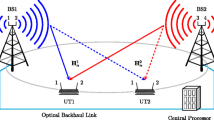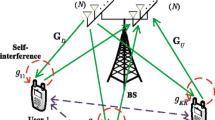Abstract
Coordinated transmission in multicell coordination networks has attracted much attentions in recent years. In the paper, we investigate one open problem in the above area, which is concerned with how to solve the closed-form optimal power allocation scheme of coordinated transmission in downlink orthogonal frequencydivision multiplexing (OFDM) systems with multiple antenna configurations and individual power constraints. A frequency-selective fading multiple-input multiple-output (MIMO) channel is considered. We derive the closed-form solutions of sum-rate capacity and optimal power allocations for coordinated transmission under the diversity case and the multiplexing case by solving the constrained optimization problems. Numerical simulations are performed to verify the derived theoretical conclusions by means of comparing the proposed optimal power allocation (OPA) scheme with the other two typical power allocation schemes. One is the power allocation scheme combining traditional water-filling with equal power (WS-EF PA). The other is equal power allocation (EPA) scheme.
Similar content being viewed by others
References
Sendonaris A, Erkip E, Aazhang B. User cooperation diversity-part I: system description. IEEE Trans Commun, 2003, 51: 1927–1938
Laneman J N, Tse D N C, Wornell G W. Cooperative diversity in wireless networks: efficient protocols and outage behavior. IEEE Trans Inform Theory, 2004, 50: 3062–3080
Ng C T K, Jindal N, Goldsmith A J, et al. Capacity gain from two-transmitter and two-receiver cooperation. IEEE Trans Inform Theory, 2007, 53: 3822–3827
Kramer G, Gastpar M, Gupta P. Cooperative strategies and capacity theorems for relay networks. IEEE Trans Inform Theory, 2005, 51: 3037–3063
Ng C T K, Goldsmith A J. The impact of CSI and power allocation on relay channel capacity and cooperation strategies. IEEE Trans Inform Theory, 2008, 7: 5380–5389
3GPP. Further Advancements for E-UTRA Physical Layer Aspects. 3GPP TR 36.814 V0.4.1. 2009
Jafar S A, Goldsmith A. Transmitter optimization for multiple antenna cellular systems. In: Proc Int Symp Information Theory, 2002. 50
Jafar S A, Foschini G J, Goldsmith A J. PhantomNet: exploring optimal multicellular multiple antenna systems. EURASIP J Appl Signal Process, 2004, 5: 591–604
Karakayali M K, Yates R D, Foschini G J. Network coordination for spectrally efficient communications in wireless networks. Ph.D. dissertation. New Jersey: The State University of New Jersey, 2007
Somekh O, Zaidel B M, Shamai S. Sum rate characterization of joint multiple cell-site processing. IEEE Trans Inform Theory, 2007, 53: 4473–4497
Jing S, Tse D N C, Soriaga J B, et al. Multicell downlink capacity with coordinated processing. EURASIP J Wirel Commun Netw, 2008, 586878
Bjornson E, Bengtsson M, Ottersten B. Optimality properties and low-complexity solutions to coordinated multicell transmission. In: IEEE Global Communications Conference (GLOBECOM), 2010. 6–10
Bjöornson E, Zakhour R, Gesbert D, et al. Cooperative multicell precoding: rate region characterization and distributed strategies with instantaneous and statistical CSI. IEEE Trans Signal Process, 2010, 58: 4298–4310
Luo B, Cui Q M, Wang H, et al. Optimal joint water-filling for OFDM systems with multiple cooperative power sources. In: IEEE Global Communications Conference (GLOBECOM), 2010. 1–5
Zhu H L, Wang J Z. Chunk-based resource allocation in OFDMA systems-part I: chunk allocation. IEEE Trans Commun, 2009, 57: 2734–2744
Paulraj A, Nabar R, Gore D. Introduction to space-time wireless communications. Cambridge: Cambridge University Press, 2003
Wang J Z, Milstein L B. CDMA overlay situations for microcellular mobile communications. IEEE Trans Commun, 1995, 43: 603–614
Fletcher R. Practical Methods of Optimization, Vol. 1: Unconstrained Optimization. New York: John Wiley and Sons, 1980
Boyd S, Vandenberghe L. Convex Optimization. Cambridge: Cambridge University Press, 1985
Holma H, Toskala A. WCDMA for UMTS. New York: Wiley, 2000
Viswanath P, Tse D N C, Anantharam V. Asymptotically optimal water-filling in vector multiple-access channels. IEEE Trans Inform Theory, 2001, 47: 241–267
Lee H W, Chong S. Downlink resource allocation in multi-carrier systems: frequency-selective vs. equal power allocation. IEEE Trans Wirel Commun, 2008, 7: 3738–3747
Author information
Authors and Affiliations
Corresponding authors
Rights and permissions
About this article
Cite this article
Cui, Q., Huang, X., Luo, B. et al. Capacity analysis and optimal power allocation for coordinated transmission in MIMO-OFDM systems. Sci. China Inf. Sci. 55, 1372–1387 (2012). https://doi.org/10.1007/s11432-012-4563-1
Received:
Accepted:
Published:
Issue Date:
DOI: https://doi.org/10.1007/s11432-012-4563-1




